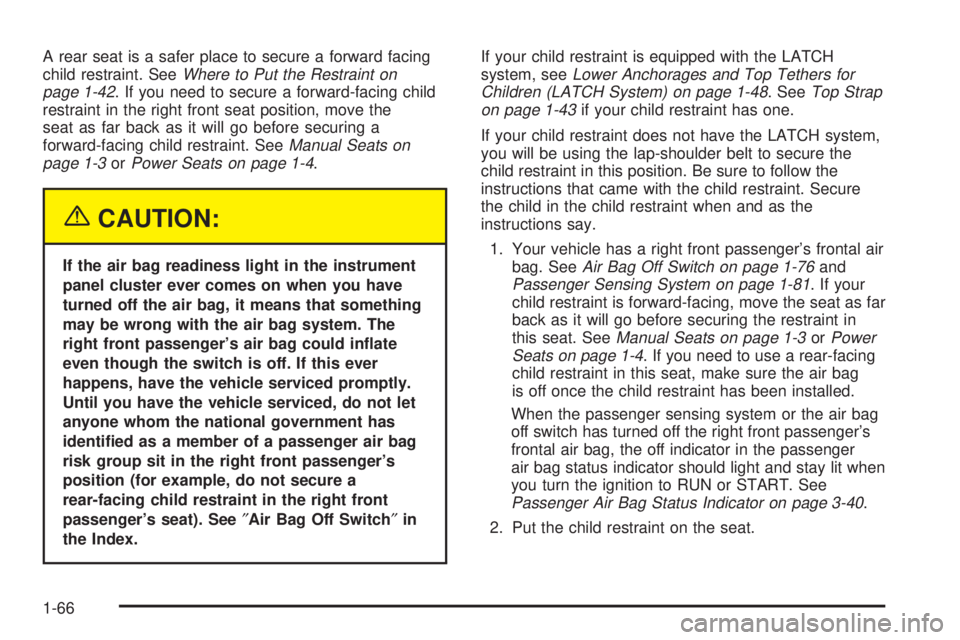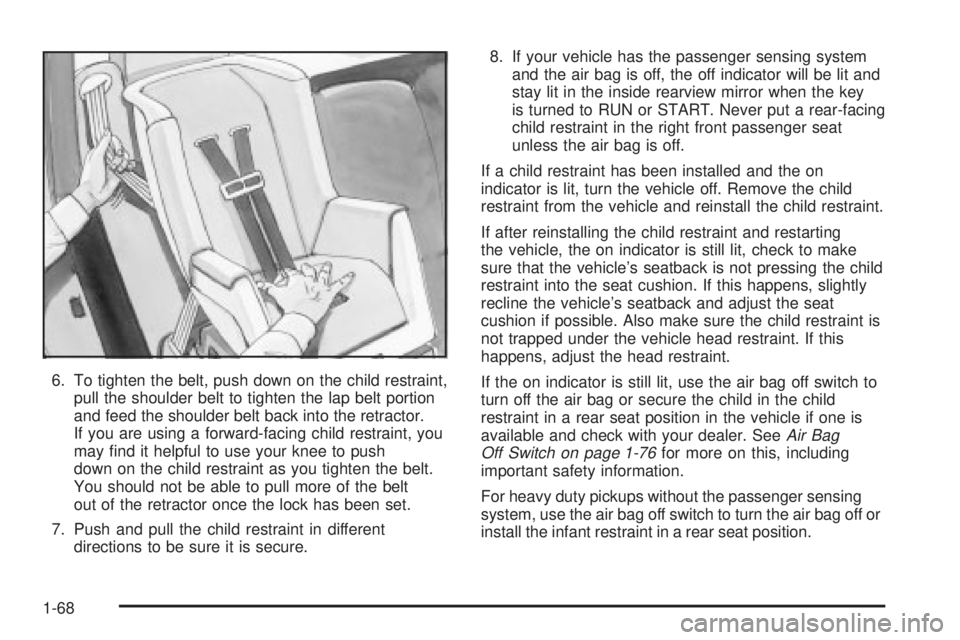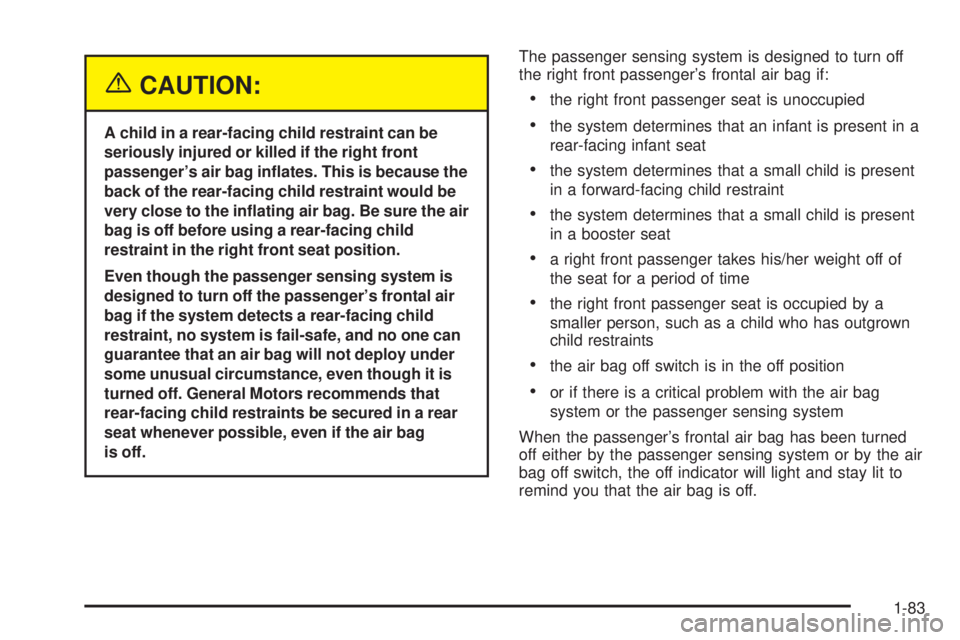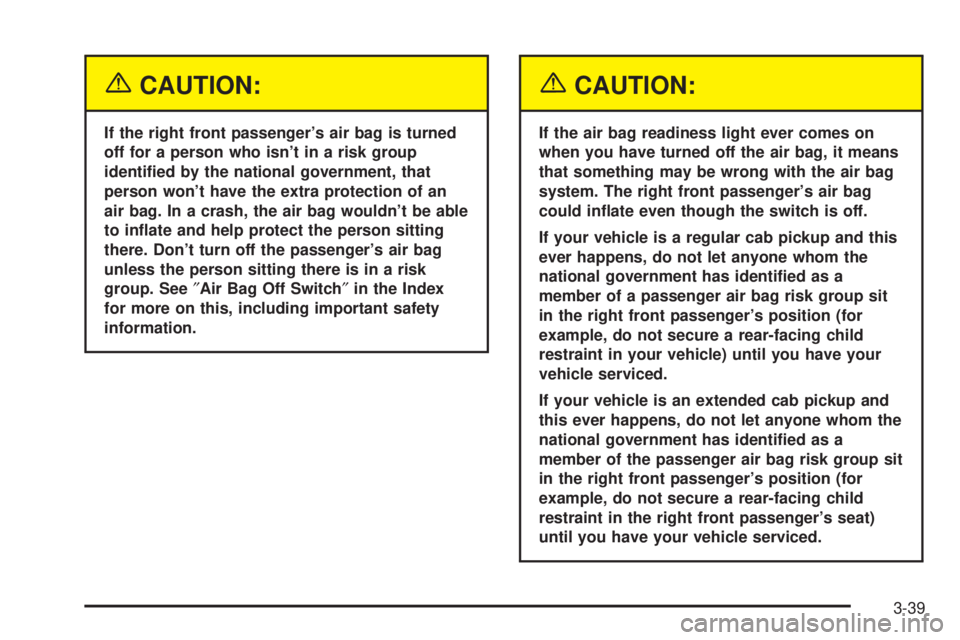2004 GMC SIERRA child seat
[x] Cancel search: child seatPage 72 of 588

A rear seat is a safer place to secure a forward facing
child restraint. SeeWhere to Put the Restraint on
page 1-42. If you need to secure a forward-facing child
restraint in the right front seat position, move the
seat as far back as it will go before securing a
forward-facing child restraint. See
Manual Seats on
page 1-3orPower Seats on page 1-4.
{CAUTION:
If the air bag readiness light in the instrument
panel cluster ever comes on when you have
turned off the air bag, it means that something
may be wrong with the air bag system. The
right front passenger's air bag could in¯ate
even though the switch is off. If this ever
happens, have the vehicle serviced promptly.
Until you have the vehicle serviced, do not let
anyone whom the national government has
identi®ed as a member of a passenger air bag
risk group sit in the right front passenger's
position (for example, do not secure a
rear-facing child restraint in the right front
passenger's seat). See²Air Bag Off Switch²in
the Index.If your child restraint is equipped with the LATCH
system, see
Lower Anchorages and Top Tethers for
Children (LATCH System) on page 1-48. SeeTop Strap
on page 1-43if your child restraint has one.
If your child restraint does not have the LATCH system,
you will be using the lap-shoulder belt to secure the
child restraint in this position. Be sure to follow the
instructions that came with the child restraint. Secure
the child in the child restraint when and as the
instructions say.
1. Your vehicle has a right front passenger's frontal air
bag. See
Air Bag Off Switch on page 1-76andPassenger Sensing System on page 1-81. If your
child restraint is forward-facing, move the seat as far
back as it will go before securing the restraint in
this seat. See
Manual Seats on page 1-3orPower
Seats on page 1-4. If you need to use a rear-facing
child restraint in this seat, make sure the air bag
is off once the child restraint has been installed.
When the passenger sensing system or the air bag
off switch has turned off the right front passenger's
frontal air bag, the off indicator in the passenger
air bag status indicator should light and stay lit when
you turn the ignition to RUN or START. See
Passenger Air Bag Status Indicator on page 3-40.
2. Put the child restraint on the seat.
1-66
Page 74 of 588

6. To tighten the belt, push down on the child restraint,
pull the shoulder belt to tighten the lap belt portion
and feed the shoulder belt back into the retractor.
If you are using a forward-facing child restraint, you
may ®nd it helpful to use your knee to push
down on the child restraint as you tighten the belt.
You should not be able to pull more of the belt
out of the retractor once the lock has been set.
7. Push and pull the child restraint in different
directions to be sure it is secure.8. If your vehicle has the passenger sensing system
and the air bag is off, the off indicator will be lit and
stay lit in the inside rearview mirror when the key
is turned to RUN or START. Never put a rear-facing
child restraint in the right front passenger seat
unless the air bag is off.
If a child restraint has been installed and the on
indicator is lit, turn the vehicle off. Remove the child
restraint from the vehicle and reinstall the child restraint.
If after reinstalling the child restraint and restarting
the vehicle, the on indicator is still lit, check to make
sure that the vehicle's seatback is not pressing the child
restraint into the seat cushion. If this happens, slightly
recline the vehicle's seatback and adjust the seat
cushion if possible. Also make sure the child restraint is
not trapped under the vehicle head restraint. If this
happens, adjust the head restraint.
If the on indicator is still lit, use the air bag off switch to
turn off the air bag or secure the child in the child
restraint in a rear seat position in the vehicle if one is
available and check with your dealer. See
Air Bag
Off Switch on page 1-76for more on this, including
important safety information.
For heavy duty pickups without the passenger sensing
system, use the air bag off switch to turn the air bag off or
install the infant restraint in a rear seat position.
1-68
Page 75 of 588

{CAUTION:
If the air bag ON indicator comes on when you
have a rear-facing child restraint installed in
the right front passenger's seat, it means that
the passenger sensing system has not turned
off the passenger's frontal air bag. A child in a
rear-facing child restraint can be seriously
injured or killed if the right front passenger's
air bag in¯ates. This is because the back of
the rear-facing child restraint would be very
close to the in¯ating air bag. Don't use a
rear-facing child restraint in the right front
passenger's seat unless the air bag is off.
To remove the child restraint, just unbuckle the vehicle's
safety belt and let it go back all the way. The safety
belt will move freely again and be ready to work for an
adult or larger child passenger.If you had turned the air bag off with the switch,
remember to be sure to use the air bag off switch to
turn on the right front passenger's air bag when
you remove the child restraint from the vehicle unless
the person who will be sitting there is a member of
a passenger air bag risk group. SeeAir Bag Off Switch
on page 1-76.
{CAUTION:
If the right front passenger's air bag is turned
off for a person who isn't in a risk group
identi®ed by the national government, that
person won't have the extra protection of an
air bag. In a crash, the air bag wouldn't be able
to in¯ate and help protect the person sitting
there. Don't turn off the passenger's air bag
unless the person sitting there is in a risk
group. See²Air Bag Off Switch²in the Index
for more on this, including important safety
information.
1-69
Page 85 of 588

·the infant has a medical condition which, according
to the infant's physician, makes it necessary for the
infant to ride in the front seat so that the driver can
constantly monitor the child's condition.
Child age 1 to 12. A child age 1 to 12 must
ride in the front seat because:
·
my vehicle has no rear seat;
·although children ages 1 to 12 ride in the rear
seat(s) whenever possible, children ages 1 to 12
sometimes must ride in the front because no space
is available in the rear seat(s) of my vehicle; or
·the child has a medical condition which, according
to the child's physician, makes it necessary for the
child to ride in the front seat so that the driver
can constantly monitor the child's condition.
Medical Condition. A passenger has a
medical condition which, according to his
or her physician:
·
causes the passenger air bag to pose a special risk
for the passenger; and
·makes the potential harm from the passenger air
bag in a crash greater than the potential harm
from turning off the air bag and allowing the
passenger, even if belted, to hit the dashboard or
windshield in a crash.
{CAUTION:
If the right front passenger's air bag is turned
off for a person who isn't in a risk group
identi®ed by the national government, that
person won't have the extra protection of an air
bag. In a crash, the air bag wouldn't be able to
in¯ate and help protect the person sitting there.
Don't turn off the passenger's air bag unless the
person sitting there is in a risk group.
1-79
Page 88 of 588

The passenger sensing system will turn off the right
front passenger's frontal air bag under certain
conditions. The driver's air bag is not part of the
passenger sensing system. In addition to the passenger
sensing system, your vehicle also has an air bag off
switch located on the instrument panel.The passenger sensing system works with sensors that
are part of the right front passenger's seat and safety
belt. The sensors are designed to detect the presence of
a properly seated occupant and determine if the
passenger's frontal air bag should be enabled (may
in¯ate) or not.
Accident statistics show that children are safer if they
are restrained in the rear rather than the front seat.
General Motors recommends that child restraints
be secured in a rear seat, including an infant riding in a
rear-facing infant seat, a child riding in a forward-facing
child seat and an older child riding in a booster seat.
Never put a child in a rear-facing child restraint in
the right front passenger seat unless the passenger air
bag status indicator shows off. Never put a rear-facing
child restraint in the right front passenger seat unless the
air bag is off. Passenger Air Bag Status Indicator ± United States
Passenger Air Bag
Status Indicator
-Canada
1-82
Page 89 of 588

{CAUTION:
A child in a rear-facing child restraint can be
seriously injured or killed if the right front
passenger's air bag in¯ates. This is because the
back of the rear-facing child restraint would be
very close to the in¯ating air bag. Be sure the air
bag is off before using a rear-facing child
restraint in the right front seat position.
Even though the passenger sensing system is
designed to turn off the passenger's frontal air
bag if the system detects a rear-facing child
restraint, no system is fail-safe, and no one can
guarantee that an air bag will not deploy under
some unusual circumstance, even though it is
turned off. General Motors recommends that
rear-facing child restraints be secured in a rear
seat whenever possible, even if the air bag
is off.The passenger sensing system is designed to turn off
the right front passenger's frontal air bag if:
·the right front passenger seat is unoccupied
·the system determines that an infant is present in a
rear-facing infant seat
·the system determines that a small child is present
in a forward-facing child restraint
·the system determines that a small child is present
in a booster seat
·a right front passenger takes his/her weight off of
the seat for a period of time
·the right front passenger seat is occupied by a
smaller person, such as a child who has outgrown
child restraints
·the air bag off switch is in the off position
·or if there is a critical problem with the air bag
system or the passenger sensing system
When the passenger's frontal air bag has been turned
off either by the passenger sensing system or by the air
bag off switch, the off indicator will light and stay lit to
remind you that the air bag is off.
1-83
Page 90 of 588

If a child restraint has been installed and the on
indicator is lit, turn the vehicle off. Remove the child
restraint from the vehicle and reinstall the child restraint
following the child restraint manufacturer's directions
and refer to
Securing a Child Restraint in the Right Front
Seat Position (Regular and Extended Cab) on
page 1-64
orSecuring a Child Restraint Designed for
the LATCH System (Front) on page 1-51.
If after reinstalling the child restraint and restarting the
vehicle, the on indicator is still lit, check to make
sure that the vehicle's seatback is not pressing the child
restraint into the seat cushion. If this happens, slightly
recline the vehicle's seatback and adjust the seat
cushion if possible. Also make sure the child restraint is
not trapped under the vehicle head restraint. If this
happens, adjust the head restraint.
If the on indicator is still lit, use the air bag off switch to
turn off the air bag or secure the child in the child
restraint in a rear seat position in the vehicle if one is
available and check with your dealer. See
Air Bag
Off Switch on page 1-76for more on this, including
important safety information.
The passenger sensing system is designed to enable
(may in¯ate) the right front passenger's frontal air
bag anytime the system senses that a person of adult
size is sitting properly in the right front passenger's seat.
When the passenger sensing system has allowed the
air bag to be enabled, the on indicator will light and stay
lit to remind you that the air bag is active.For some children who have outgrown child restraints
and for very small adults, the passenger sensing system
may or may not turn off the right front passenger's
frontal air bag, depending upon the person's seating
posture and body build. Everyone in your vehicle
who has outgrown child restraints should wear a safety
belt properly Ð whether or not there is an air bag
for that person.
If a person of adult-size is sitting in the right front
passenger's seat, but the off indicator is lit, it could be
because that person is not sitting properly in the seat or
the air bag off switch is in the off position. If this
happens and the switch is in the proper position, turn
the vehicle off and ask the person to place the seatback
in the fully upright position, then sit upright in the
seat, centered on the seat cushion, with the person's
legs comfortably extended. Restart the vehicle and have
the person remain in this position for about two
minutes. This will allow the system to detect that person
and then enable the passenger's air bag.
1-84
Page 203 of 588

{CAUTION:
If the right front passenger's air bag is turned
off for a person who isn't in a risk group
identi®ed by the national government, that
person won't have the extra protection of an
air bag. In a crash, the air bag wouldn't be able
to in¯ate and help protect the person sitting
there. Don't turn off the passenger's air bag
unless the person sitting there is in a risk
group. See²Air Bag Off Switch²in the Index
for more on this, including important safety
information.
{CAUTION:
If the air bag readiness light ever comes on
when you have turned off the air bag, it means
that something may be wrong with the air bag
system. The right front passenger's air bag
could in¯ate even though the switch is off.
If your vehicle is a regular cab pickup and this
ever happens, do not let anyone whom the
national government has identi®ed as a
member of a passenger air bag risk group sit
in the right front passenger's position (for
example, do not secure a rear-facing child
restraint in your vehicle) until you have your
vehicle serviced.
If your vehicle is an extended cab pickup and
this ever happens, do not let anyone whom the
national government has identi®ed as a
member of the passenger air bag risk group sit
in the right front passenger's position (for
example, do not secure a rear-facing child
restraint in the right front passenger's seat)
until you have your vehicle serviced.
3-39